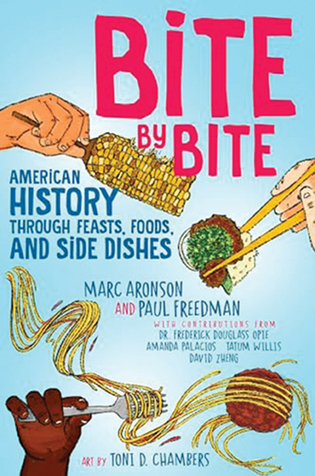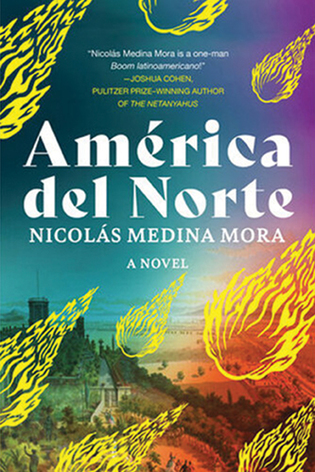
Bite by Bite: American History through Feasts, Foods, and Side Dishes
Marc Aronson and Paul Freedman, with contributions by Frederick Douglass Opie, Amanda Palacios, Tatum Willis ’20 and David Zheng ’23
Simon & Schuster, $17.99
Reviewed by Cathy Shufro
In December 1803, in the final weeks of French control of New Orleans, the new colonial governor staged an all-night banquet. The pièce de résistance: 24 variations on gumbo.
In Bite by Bite, historians Marc Aronson (Rutgers) and Paul Freedman (Yale) describe how Governor Pierre Clément de Laussat asserted French hegemony by serving a stew that in fact embodied a half dozen food cultures. Some Louisiana chefs thickened their gumbo with a French fat-and-flour roux; others used okra, an African transplant; or powdered sassafras, from Choctaw cookery. (As for Laussat, his tenure lasted only 20 days: Louisiana had been sold to the US.)
With stories like this, Bite by Bite explores how food and history intersect. An early chapter in this slim book describes how, for thousands of years, Mexican and Amazonian farmer-scientists selectively bred a wild grass to create corn as we know it. The authors call it an “invention that transformed the Americas.” Corn fueled great civilizations.
A section on the pleasures of fizzy water describes segregation in soda fountains. The civil rights pioneer Pauli Murray ’65JSD led one of the first sit-in protests of these establishments. In 1943, Murray convinced Howard University classmates to picket the whites-only Little Palace Cafeteria near campus. The students prevailed.
Each of 12 chapters spotlights a food or dining trend, ranging from hush puppies to food trucks to General Tso’s chicken. A history of nachos reveals that the snack is not a venerable Tex-Mex tradition, but rather the on-the-fly creation of a border-town cook during World War II. The cook’s name was Nacho.
The book concludes with a look at the current American foodscape: supermarkets are selling almond and oat milk alongside cows’ milk, and Manhattan’s Michelin-starred Eleven Madison Park has switched to an entirely plant-based menu.
Geared toward readers ten and up, but sophisticated enough to delight adults, Bite by Bite shows how historical events, cultural currents, and, sometimes, serendipity, all shape what we eat. Nachos, anyone?
Cathy Shufro teaches writing at Wesleyan University and is a Yale writing tutor.
__________________________________________________________________

América del Norte
By Nicolás Medina Mora ’13
Soho Press, $27
Reviewed by Alex Beam ’75
If you are going to write a first novel, you might as well bring it—meaning pour every ounce of your literary energy and personal experience into your debut manuscript and hope for the best. Nicolás Medina Mora brings it, all right, in this discursive, often brilliant, emotional novel about a young writer who sounds a lot like Medina Mora himself. Medina Mora was born and raised in Mexico City, attended Yale, and got into the revered writing program at the University of Iowa. His fictional protagonist—Sebastián Arteaga y Salazar—likewise attended Yale and Iowa, and can’t decide whether he wants to live out his destiny as a scion of the Mexican elite, or to embrace his second homeland and become an “American, which is to say an amnesiac.”
Mexico, Sebastián notes sardonically, is a country blessed with “a strong literature and a weak currency.” He writes, “I come from a place that . . . has cultivated the art of losing, of finding beauty in failure. America, by contrast, is a country of winners, or, more accurately, of optimists.” Confronted by recurring visa problems during the Trump administration that culminate in a tense Homeland Security interview after flying into the San Francisco airport with his American girlfriend, Sebastián has an epiphany: “There was no denying it anymore: I loved America more than myself, but America didn’t love me back.”
One hesitates to call América del Norte “a big weird, Latin American novel,” but that’s what Sebastián’s friend Esteban calls the young writer’s secret ambition. Norte is blindingly ambitious, and almost always successful. Mora aspires to combine his personal bildungsroman with an idiosyncratic and readable history of Mexico, a love story, and some trenchant social satire mainly directed at the University of Iowa. (Yale dodges a bullet here.) And it is weird. If you can’t read Spanish, random chunks of the book will be lost on you. If you don’t read Amharic, then the last two lines of the epilogue—“In which nothing is revealed”—are lost on you, too.
Norte must have been a fun novel to write, and it’s a joyful novel to read. “Had I written an American book,” Sebastián tells his Iowa thesis adviser, “the protagonist would become a US citizen in the end.” Read it and find out.
Alex Beam ’75 is the author, most recently, of Broken Glass: Mies van der Rohe, Edith Farnsworth, and the Fight Over a Modernist Masterpiece.
__________________________________________________________________

Dead Pilots Society
Hosted by Andrew Reich ’90 and Ben Blacker
Maximum Fun
Reviewed by Mark Blankenship ’05MFA
Failing’s not so bad if you’re among friends. That’s the spirit of Dead Pilots Society, a long-running podcast that resurrects comedy scripts from successful writers that were sold and developed but never actually filmed. Each rescued pilot gets two episodes: one in which famous actors do a table reading of the script, and another in which host Andrew Reich ’90 interviews the writers about their lives, careers, and why this particular project died.
Though they’re released under the same banner, these installments can be experienced as two different podcasts. The table reading episodes deliver larky entertainment, with solid performances of material polished enough to make it clear why a network once got interested. A particular highlight is Episode 150, when Billy Gardell—a Mike & Molly star—reads the part of a substitute teacher trying to spend less time hanging out with his grandfather and more time looking for love. Gardell instantly finds the script’s rhythm and lands joke after joke.
Charming as these radio dramas are, it’s the interviews that merit relistening. They run roughly an hour, allowing Reich, who wrote several seasons of Friends, to talk with his fellow scribes about the occasional ups and many downs of the writer’s life. This includes juicy anecdotes about working in Hollywood. Even better: the moments when writers explore what makes them persevere.
Perseverance is key. Even at the top of the profession, rejection is a way of life, and carrying on requires both discipline and resilience. It’s heartening to hear these successful and talented people speak so frankly about pushing through hard times. Yet they still find joy in the day-to-day work of being an artist. It’s enough to inspire anyone who feels the urge to create.
MarkBlankenship ’05MFA is a reporter and critic who has been covering arts and culture for over 20 years.
 loading
loading

